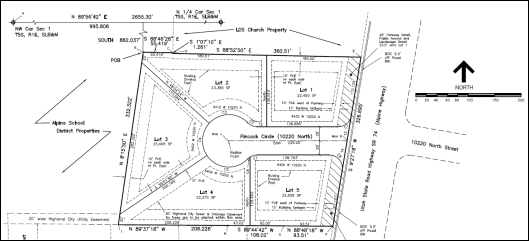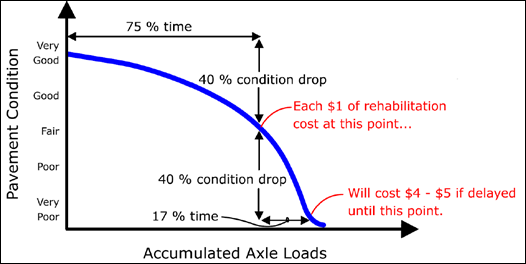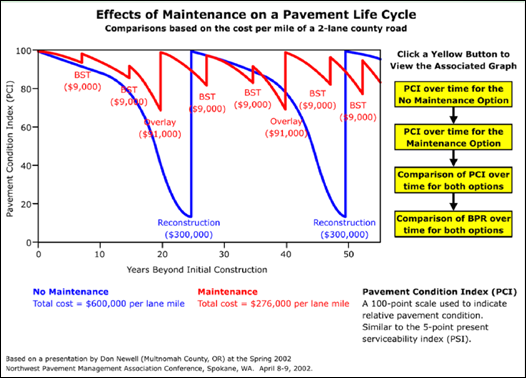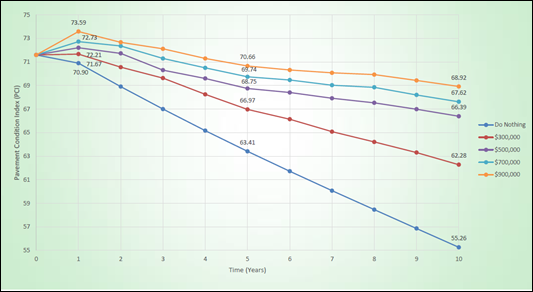The most interesting part of the council meeting was the Road Maintenance Presentation and Discussion, which I will discuss at the end of the post. Here is a brief summary of the votes which were taken:
| # | Description | Pass/Fail |
| 1. | Motion: Ratify the Mayors Appointment of Kristi Vick to the Open Space Committee | P |
| 2. | Motion: Ratify the Mayors Appointment of Scott Smith to the Library Board | P |
| 3. | Ordinance: Amend Municipal Code 15.04.010, Adopting State Construction Code. | P |
| 4. | Motion: Final Plat Approval for Pinnock Estates | P |
| 5. | Ordinance: Amend Chapters 12.30 & 13.31, Removal of Neighborhood Trails | P |
Item 3: Staff made the following recommendation:
The State of Utah has mandatory standards for building construction which are the International Residential Code (I.R.C.) and the International Building Code (I.B.C.) and related codes such as the mechanical code, fire code, etc. Each local municipal entity is required to implement and adhere to these Codes. New codes are adopted by the State every three years. Most builders are already following the 2012 Codes.
Currently, the Municipal Code needs to be amended every three years once the State codes are adopted. Staff is proposing a modification to the Municipal Code that would automatically adopt the new codes once they are adopted by the State. This change will improve efficiency and ensure the proper codes are used.
Given that the city is required by the state to use codes which are updated every three year I supported motion to revise our ordinance so that we don’t have to amend it every three years to adopt the updated state codes. Brian Braithwaite made a friendly amendment to ask the city to include a link to state code on our site and ensure that the updated code could be accessed through the city library or city staff.
Item 4: Pinnock Estates (located at 10215 N Alpine Hwy). Is a 5 home development that is zone R-120 (average lot size 20,000 sq./ft.). The permit to build was issued in 2008 and has expired. The developer asked the council for final approval. The lot sizes are all over 22,000 sq. ft. The council unanimously approved.
Item 5: Amendments to the Removal of Neighborhood Option Trails and Designation of Open Space Property for Disposal city ordinances. The Open Space committee recommended a number of changes to simplify and clarify the code. These were approved unanimously.
Road Maintenance Presentation and Discussion
Matt Shipp (City Engineer) along with Marty Beaumont (JUB – the contractor that performed the road condition inventory in 2011) presented their current thoughts on the maintenance of roads considered to be in good condition. These were rated as A, B, or C condition roads when the road study was performed in 2011. Road work on poor condition roads (D & F) will be part of a road capital plan which will come out later this year (September).
Note, in a previous post entitled “Road Maintenance and Your Dollars” I reviewed the study and included links to a couple of short articles that discuss road maintenance. They are worth reading.
JUB worked with the city to put the road inventory data into a computer model that can be used to project how roads will deteriorate over time and the costs associated with maintaining them. The model can help determine the order that roads should be worked on to maximize the effectiveness of the dollars being spent.
Two key concepts to consider is that as roads deteriorate over time, the rate of deterioration increases and the cost to repair/maintain roads increases significantly as their condition degrades. The basic principle is that roads cost less to maintain over the long-term if they are well maintained. The charts below illustrates this concept.
The Changing Cost of Road Maintenance/Repair
One recommendation from JUB was that rather than divide the city into five zones and then rotate the focus of road work one a different zone each year, as was determined last year, that each year the highest priority roads in the city be worked on regardless of location or zone. I agree with this approach rather than the zone concept.
The council asked Matt to do a five year plan based on $500,000 and then provide the council with some estimates as to how the overall road condition would be improved if additional funding were found.
Matt did provide a chart which showed the impact of various levels of funding on the overall condition of the roads which are currently in good condition (i.e. those having a PCI rating of 55 to 100 – grades A, B & C).
Effect of Various Annual Spending Levels on PCI Over 10 Years.
The recommendation from JUB was that a 10-year target of 66 to 68 would be a good range to end at. Low than that the roads would degrade relatively quickly (refer to first chart) and raise the cost of maintenance after the 10 year mark.
Please note about 70% of the surface area of Highland City maintained roads have a PCI rating of 55 to 100 (grades A through C).
Caveats: I did not ask if the model has been updated with current road conditions (the study was done in 2011 and it is now 2014. I would hope so but it will be best to find out.
Items from Mayor & City Council Comments
- The city needs to communicate to residents that the watering restrictions that were in place last year remain in affect. The Mayor’s section of the next city newsletter will communicate that. The mayor also noted that the city is still growing and we will not be getting additional water rights so the amount of available to each household will decline over time. Additionally, the underground water rights in our are 40% over-allocated.so that as addition wells are drilled that will reduce the amount available per acre.
—Tim Irvin and Mark Thompson - City staff should have 1st draft budgets available for review by the council by mid April. — Brian Braithwaite, Aaron Palmer
- A suggestion was made that the council use 5th Tuesdays for discussions / Q&A with residents. Each such meeting would have a focus area for discussion. Everyone thought that having periodic (quarterly?) meetings like this was a good idea, although it need not always be 5th Tuesdays.
— Dennis LeBaron, Brian Braithwaite, Mark Thompson, Rod Mann
Lessons Learned
- I was reminded that discussions on issues, when people are not in a defensive posture, generally end up with improved solutions. The road discussion and the 5th Tuesday meeting are examples of this. In both cases I felt like at the end of the discussion we were in a much better place than when we started.
- Council members can participate effectively even if they are not physically present. I was out of town and attended the meeting using a phone. I benefited from participating and was still able to contribute to the discussions.
Link Summary:





No comments:
Post a Comment
Thanks for taking the time to share your thoughts regarding this post.